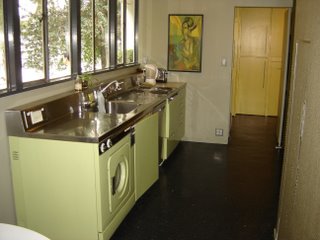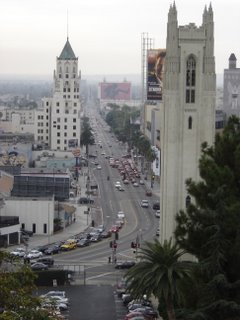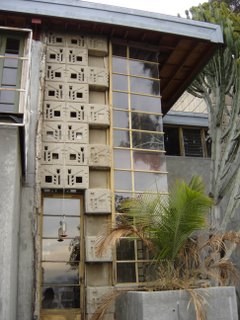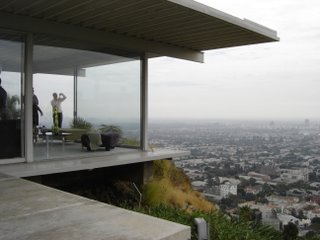
As you know by now, Tim and I love Los Angeles and one of the things we love most about the city is its architecture. Few things in this world can compare to the architectural magnificence of Bullocks Wilshire or the simple beauty of the Eames house overlooking Pacific Palisades. This past weekend we were thrilled to be able to tour some the most famous houses in Los Angeles.
On Saturday, we participated in the Silver Lake Modernism tour of mid-twentieth century homes designed and built by some of the most prominent architects of the period. First up were the Bubeshko apartments, designed by Rudolph Schindler, one of the most influential local architects, possibly second in importance only to Frank Lloyd Wright, his mentor. Constructed in the late 1930s, the multifamily dwellings are set back against a hillside and make liberal use of plywood. I was ready to sell our house and move into the topmost apartment until I learned the monthly rent was $3500!
 We also saw outstanding homes designed by Richard Neutra, Rodney Walker and Gregory Ain. But my favorite was the Meyers house, built in 1938 by Raphael Soriano, who specialized in the use of prefabricated materials and built-in furniture. Unlike most of the other homes we visited, this one had no view of the Silver Lake reservoir; but it did have an amazing kitchen (pictured here) outfitted in metal avocado-green cabinets. Awarded as a prize on the 1950s TV show “The Price is Right,” the self-contained sink-and-stove unit included an all-in-one washer-dryer, which was the talk of the tour. Thank goodness we just remodeled our own kitchen last year otherwise I might have felt compelled to change to an all-avocado motif.
We also saw outstanding homes designed by Richard Neutra, Rodney Walker and Gregory Ain. But my favorite was the Meyers house, built in 1938 by Raphael Soriano, who specialized in the use of prefabricated materials and built-in furniture. Unlike most of the other homes we visited, this one had no view of the Silver Lake reservoir; but it did have an amazing kitchen (pictured here) outfitted in metal avocado-green cabinets. Awarded as a prize on the 1950s TV show “The Price is Right,” the self-contained sink-and-stove unit included an all-in-one washer-dryer, which was the talk of the tour. Thank goodness we just remodeled our own kitchen last year otherwise I might have felt compelled to change to an all-avocado motif. After a good night’s rest, we were ready to tackle a second architectural tour—this one sponsored by the MAK Center for Art and Architecture located at Rudolph Schindler’s former residence. The centerpiece of the tour promised to be Case Study House #22, arguably the most famous house in Los Angeles. Designed by Pierre Koenig, the house was built in 1959 as part of the “case study” series of Southern California prototypes featured in “Arts and Architecture” magazine throughout the 1940s and ‘50s. House #22 became an icon when Julius Shulman famously photographed it, in 1960, jutting out over a nighttime Los Angeles skyline. No picture since has captured so well the supposed modern lifestyle of mid-twentieth century LA.
After a good night’s rest, we were ready to tackle a second architectural tour—this one sponsored by the MAK Center for Art and Architecture located at Rudolph Schindler’s former residence. The centerpiece of the tour promised to be Case Study House #22, arguably the most famous house in Los Angeles. Designed by Pierre Koenig, the house was built in 1959 as part of the “case study” series of Southern California prototypes featured in “Arts and Architecture” magazine throughout the 1940s and ‘50s. House #22 became an icon when Julius Shulman famously photographed it, in 1960, jutting out over a nighttime Los Angeles skyline. No picture since has captured so well the supposed modern lifestyle of mid-twentieth century LA.The first site we visited was the Harpel house, built in 1956 by John Lautner. Located atop a long 45-degree-angled driveway, the house is currently undergoing renovation, but still offers a fantastic view of the San Fernando Valley and especially Universal Studios. Tim took one look and whispered, “This tour is already much better than yesterday’s!”—proving that you can take the boy out of the Valley, but you can never take the Valley out of the boy. The view WAS stunning, but I was far more impressed by the Chemosphere, which we could see through the trees flying above the Harpel House. The Chemosphere (see above), also designed by Lautner, is another famous LA house that sits atop a long pole, looking very much like a wooden flying saucer. Although we couldn’t go inside, it was very exciting to see yet another Los Angeles icon up close and personal.

 From the Harpel house, we snaked down a very skinny road to the Kallis house, which was built by Schindler in 1946, and then down to Hollywood, where we were next scheduled to see Frank Lloyd Wright’s Freeman house. Faced with another steep and skinny road, I insisted on parking at the Hollywood and Highland mall three blocks away. “This house better be worth it,” Tim mumbled under his breath as we started to walk up yet another 45-degree-angled driveway. And indeed it was, for there—quite suddenly!—was one of Wright’s fabulous “textile houses,” made of precast concrete blocks decorated with Mayan-Islamic patterns. Although the house is no longer habitable—in fact, we had to sign an insurance release before we were allowed inside—it is nonetheless captivating with its imposing concrete walls and wonderful views of Hollywood. Everyone was extremely grateful that the University of Southern California bought the building in hopes of restoring it, some day, to its glorious splendor.
From the Harpel house, we snaked down a very skinny road to the Kallis house, which was built by Schindler in 1946, and then down to Hollywood, where we were next scheduled to see Frank Lloyd Wright’s Freeman house. Faced with another steep and skinny road, I insisted on parking at the Hollywood and Highland mall three blocks away. “This house better be worth it,” Tim mumbled under his breath as we started to walk up yet another 45-degree-angled driveway. And indeed it was, for there—quite suddenly!—was one of Wright’s fabulous “textile houses,” made of precast concrete blocks decorated with Mayan-Islamic patterns. Although the house is no longer habitable—in fact, we had to sign an insurance release before we were allowed inside—it is nonetheless captivating with its imposing concrete walls and wonderful views of Hollywood. Everyone was extremely grateful that the University of Southern California bought the building in hopes of restoring it, some day, to its glorious splendor.
 Anxious to get to the case study house, we quickly toured a nearby residence designed by Irving Gill in 1917 and then headed back to the Hollywood Hills. More windy roads (luckily we were driving the Miata) and one last 45-degree angled driveway and we were finally there. The outside is quite unassuming: a corrugated steel carport. We then walked through an archway and—yikes!—there was the entire city of Los Angeles at our feet! The panorama, from the Griffith Park Observatory to the ocean, was quite simply phenomenal. And to top it off, there was the famous living room window happily dangling over it all. Everyone just stood there in rapt amazement.
Anxious to get to the case study house, we quickly toured a nearby residence designed by Irving Gill in 1917 and then headed back to the Hollywood Hills. More windy roads (luckily we were driving the Miata) and one last 45-degree angled driveway and we were finally there. The outside is quite unassuming: a corrugated steel carport. We then walked through an archway and—yikes!—there was the entire city of Los Angeles at our feet! The panorama, from the Griffith Park Observatory to the ocean, was quite simply phenomenal. And to top it off, there was the famous living room window happily dangling over it all. Everyone just stood there in rapt amazement. As beautiful as it all was, though, I was still happy to get back to the flatlands to our small 1947 traditional home. Perhaps someday someone will offer a tour of postwar houses in Culver City and our house will become a celebrity, too. Hmmm...time to hire a landscaper...
10/2/06

No comments:
Post a Comment